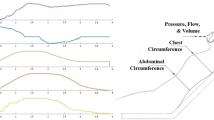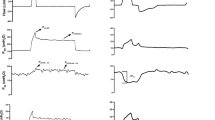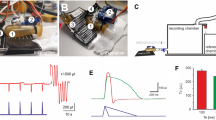Abstract
Study design:
Cross-sectional, experimental.
Objectives:
To investigate and compare static lung volumes and breathing patterns in persons with a cervical spinal cord lesion during breathing at rest, ordinary deep breathing, positive expiratory pressure (PEP) and inspiratory resistance-positive expiratory pressure (IR-PEP) with and without an abdominal binder (AB).
Setting:
The outpatient clinic at the Spinal Unit at Sahlgrenska University Hospital, Göteborg, Sweden.
Method:
The study group consisted of 20 persons with complete cervical cord lesion at C5–C8 level. Breathing patterns and static lung volumes with and without an AB were measured using a body plethysmograph.
Results:
With an AB, static lung volumes decreased, vital capacity increased, breathing patterns changed only marginally and functional residual capacity remained unchanged during PEP and IR-PEP.
Conclusion:
Evidence supporting the general use of an AB to prevent respiratory complications by means of respiratory training is questionable. However, the interindividual variation in our results indicates that we cannot rule out that some patients may benefit from the treatment.
Sponsorship:
This work was supported by grants from the Memorial Foundation of the Swedish Association of registered Physiotherapists and the Association of Cancer and Road Accident Victims, Sweden.
Similar content being viewed by others
Log in or create a free account to read this content
Gain free access to this article, as well as selected content from this journal and more on nature.com
or
References
DeVivo MJ, Krause JS, Lammertse DP . Recent trends in mortality and causes of death among persons with spinal cord injury. Arch Phys Med Rehabil 1999; 80: 1411–1419.
De Troyer A, Estenne M . Review article: the expiratory muscles in tetraplegia. Paraplegia 1991; 29: 359–363.
Bhaskar KR, Brown R, O'sullivan DD, Melia S, Duggan M, Reid L . Bronchial mucus hypersecretion in acute quadriplegia. Macromolecular yields and glycoconjugate composition. Am Rev Dis 1991; 143: 640–648.
Hess DR . The evidence for secretion clearance techniques. Respir Care 2001; 46: 1276–1293.
Estenne M, Gevenois PA, Kinnear W, Soudon P, Heilporn A, De Troyer A . Lung volume restriction in patients with chronic respiratory muscle weakness: the role of microatelectasis. Thorax 1993; 48: 698–701.
Mishima M et al. Respiratory impedance during positive expiratory airway pressure in patients with chronic obstructive pulmonary disease. Front Med Biol Eng 1999; 9: 63–73.
Bodin P, Kreuter M, Bake B, Fagevik Olsén M . Effects of breathing exercises on breathing patterns in persons with tetraplegia. Spinal Cord 2003; 41: 290–295.
Goldman JM, Rose LS, Williams SJ, Silver JR, Denison DM . Effect of abdominal binders on breathing in tetraplegic patients. Thorax 1986; 41: 940–945.
Estenne M, Van Muylem A, Gorini M, Kinnear W, Heilporn A, De Troyer A . Effects of abdominal strapping on forced expiration in tetraplegic patients. Am J Respir Crit Care Med 1998; 157: 95–98.
Estenne M, De Troyer A . Mechanism of postural dependence of vital capacity in tetraplegic subjects. Am Rev Respir Dis 1987; 135: 367–371.
Forner JV . Lung volumes and mechanics of breathing in tetraplegics. Paraplegia 1980; 18: 258–266.
Rutchik A, Weissman A, Almenoff P, Spungen A, Baumann W, Grimm D . Resistive inspiratory muscle training in subjects with chronic cervical spinal cord injury. Arch Phys Med Rehabil 1998; 79: 293–297.
ASIA/IMSOP. Internationel standards for neurological and functional classification of spinal cord injury – Revised 1992. American Spinal Cord Injury Association, Chicago, 1992.
Quanjer, PhH, Tammeling GJ, Cotes JE, Pedersen OF, Peslin R, Yernault JC . Lung volumes and forced ventilatory flows. Standardisation of lung function tests. Eur Respir J 1993; 6(Suppl 16): 5–40.
Hart MC, Orzalesi MM, Cook CD . Relation between anatomic respiratory dead space and body size and lung volume. J Appl Physiol 1963; 18: 519–522.
Bradley JV . Distribution Free Statistical Test. Prentice-Hall: Engalwood-cliffs, NJ, 1968, pp. 78–80.
McCool FD, Pichurko BM, Slutsky AS, Sarkarati M, Rossier A, Brown R . Changes in lungvolume and rib cage configuration with abdominal binding in Quadriplegia. J Appl Physiol 1986; 60: 1198–1202.
Danon J, Druz WS, Goldberg NB, Sharp JT . Function of the isolated paced diaphragm and the cervical accessory muscles in C1 quadriplegics. Am Rev Respir Dis 1979; 119: 909–919.
Pokorski M, Morikawa T, Takaishi S, Masuda A, Ahn B, Honda Y . Ventilatory responses to chemosensory stimuli in quadriplegic subjects. Eur Respir J 1990; 3: 891–900.
Loveridge B, Dubo H . Breathing pattern in chronic quadriplegia. Arch Phys Med Rehabil 1990; 71: 495–499.
Lin KH, Wu HD, Chang CW, Wang TG, Wang YH . Ventilatory and mouth occlusion pressure responses to hypercapnia in chronic tetraplegia. Arch Phys Med Rehabil 1998; 79: 795–799.
Fagevik OM, Lönroth H, Bake B . Effects of breathing exercises on breathing patterns in obese and normal subjects. Clin Physiol 1999; 19: 251–257.
Liaw MY, Lin MC, Cheng PT, Wong MK, Tang FK . Resistive inspiratory muscle training: its effectiveness in patients with acute complete cervical cord injury. Arch Phys Med Rehabil 2000; 81: 752–756.
Author information
Authors and Affiliations
Rights and permissions
About this article
Cite this article
Bodin, P., Fagevik Olsén, M., Bake, B. et al. Effects of abdominal binding on breathing patterns during breathing exercises in persons with tetraplegia. Spinal Cord 43, 117–122 (2005). https://doi.org/10.1038/sj.sc.3101667
Published:
Issue date:
DOI: https://doi.org/10.1038/sj.sc.3101667



